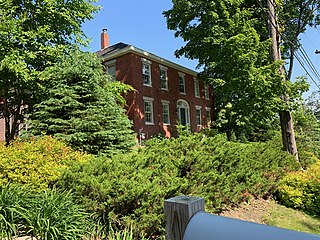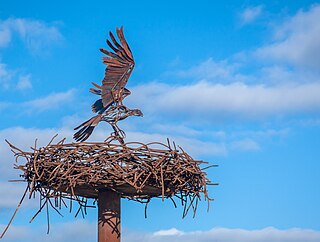
Casco Bay is an inlet of the Gulf of Maine on the coast of Maine in the United States. The National Oceanic and Atmospheric Administration's chart for Casco Bay marks the dividing line between the bay and the Gulf of Maine as running from Bald Head on Cape Small in Phippsburg west-southwest to Dyer Point in Cape Elizabeth. The city of Portland and the Port of Portland are on Casco Bay's western edge.

Streetcars in Washington, D.C. transported people across the city and region from 1862 until 1962.

Streetcars and interurbans operated in the Maryland suburbs of Washington, D.C., between 1890 and 1962.

The railroad history of Portland, Maine, began in 1842 with the arrival of the Portland, Saco & Portsmouth Railroad (PS&P). Most of the rail activity in Portland concerned agricultural goods bound for export and European import freight. But Maine's largest city also enjoyed 125 years of continuous passenger rail service from 1842 until 1967, and has been served by Amtrak since 2001. For most of Portland's history, passenger train schedules were designed with intercity travel—to Boston, Montreal, Nova Scotia, and points west—rather than daily commuting.

Cousins Island is an island in Casco Bay within the town of Yarmouth in Cumberland County, Maine, United States. It is listed as a census-designated place, with a population of 490 as of the 2010 census. The CDP is part of the Portland–South Portland–Biddeford, Maine Metropolitan Statistical Area.

Yarmouth is a town in Cumberland County, Maine, United States, twelve miles north of the state's largest city, Portland. When originally settled in 1636, as North Yarmouth, it was part of the Massachusetts Bay Colony, and remained part of its subsequent incarnations for 213 years. In 1849, twenty-nine years after Maine's admittance to the Union as the twenty-third state, it was incorporated as the Town of Yarmouth.

The Maine Central Railroad Company main line extended from Portland, Maine, east to the Canada–US border with New Brunswick at the Saint Croix–Vanceboro Railway Bridge. It is the transportation artery linking Maine cities to the national railway network. Sections of the main line had been built by predecessor railroads consolidated as the Maine Central in 1862 and extended to the Canada–US border in 1882. Through the early 20th century, the main line was double track from South Portland to Royal Junction, where it split into a lower road through Brunswick and Augusta and a back road through Lewiston which converged at Waterville into single track to Bangor and points east. Westbound trains typically used the lower road with lighter grades, while eastbound trains of empty cars used the back road. This historical description does not include changes following purchase of the Maine Central Railroad by Guilford Transportation Industries in 1981 and subsequent operation as part of Pan Am Railways.

Royal River Park is an urban park in Yarmouth, Maine, United States. It is located to the northwest of the town center, between East Elm Street to the west and Bridge Street to the east. U.S. Route 1 runs through the park via an overpass.

Westcustogo Inn was an inn and restaurant in Yarmouth, Maine, United States. Located at 10 Princes Point Road, it was in business, albeit not continuously, for 83 years.

Pleasant Street is a historic street in Yarmouth, Maine, United States. It was formerly part of the Atlantic Highway, a precursor to U.S. Route 1. It connects to Lafayette Street, part of today's Maine State Route 88, at Pleasant Street’s southern and northern ends. It has existed since at least 1761, which is when a milestone was placed on the street, on the order of Benjamin Franklin, due to its being on the King's Highway, to denote its distance from Boston, Massachusetts. As part of his duties, Franklin conducted inspections of the roads that were used for delivering mail. One method of charging for mail service was by mileage, so Franklin invented an odometer to measure mileage more accurately. The King's Highway, as a result, morphed into the Post Road.

Joseph York Hodsdon was an American businessman and politician from Maine. A resident of Yarmouth, he was a Republican state senator from 1899 to 1901 and a shoe manufacturer.
Herbert A. MerrillDDS was an American dentist and field officer.

Casco Castle was a resort in South Freeport, Maine, United States. Built in 1903, it was intended to resemble a castle. Designed by William R. Miller and overlooking Casco Bay immediately to its east, it burned down in 1914. All that now remains is its 185-foot (56 m) tall stone tower, which is now on private property, inaccessible to the public. The tower can be viewed from Harraseeket Road, a few yards closer to the shoreline, or from Winslow Memorial Park, directly to the south across the Harraseeket River. The main part of the building was to the south, with the tower on its northern side, connected by a bridge.

The First Falls are the first of four waterfalls in Yarmouth, Maine, United States. They are located on the Royal River, approximately a mile from its mouth with inner Casco Bay at Yarmouth Harbor and around 0.35 miles (0.56 km) downstream of the Second Falls. The river appealed to settlers because its 45-foot rise in close proximity to navigable water each provided potential waterpower sites. As such, each of the four falls was used to power 57 mills between 1674 and the mid-20th century.

Martin's Point Bridge spans the Presumpscot River in Maine, United States, near the river’s mouth with Casco Bay. It connects Falmouth Foreside, at Mackworth Point, in the north, to the East Deering neighborhood of Portland, at Martin's Point, in the south. 1,300 feet (400 m) in length, it carries vehicular and pedestrian traffic of U.S. Route 1. The bridge is two lanes, including a bicycle lane in each, with a pedestrian lane on the eastern side. A similar plan for the western side of the bridge was abandoned.
Amos Fitz Gerald was a railroad engineer from Maine, United States. He was nicknamed the "Electric Railway King" of the state due to his building 125 miles of Maine's early railroads.

Underwood Spring Park was a 19th- and 20th-century pleasure resort overlooking Casco Bay in Falmouth Foreside, Maine, United States. Containing an open-air theater, a casino and a gazebo, it was a popular gathering spot serviced by the trolley cars of the Portland and Yarmouth Electric Railway. The Portland and Yarmouth Electric Railway Company opened the park, located to north of the town landing, on July 18, 1899, to promote the line's service to and from Portland, Maine's largest city, every fifteen minutes. A looped spur off the main line was built the month following the resort's completion to facilitate the ease of passengers' arrivals.

The Metro Breez is an express bus service in Southern Maine, United States, provided by Greater Portland Metro. It runs thirteen times on weekdays and six times on Saturdays between Portland, the state's largest city, and Brunswick, around 30 miles (48 km) to the northeast, with stops in Yarmouth and Freeport.

Portland Railroad Company (PRR) was a trolleycar service that operated in Portland, Maine, between 1860 and 1941.


















